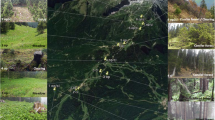Abstract
We assessed the potential eco-toxicological risks of the herbicide acetochlor on fungal communities in the microcosm of black soil using 28S rRNA gene-PCR-DGGE and clone library analysis. The acetochlor was applied to black soil at four concentrations (0-control, 50, 150, and 250 mg/kg). The DGGE fingerprint patterns indicated that acetochlor stimulated fungal communities at day 7 after application, after which there was a suppression effect. The fungal communities in acetochlor-treated soil gradually became more like that of the control during the 60-day experimental period. Diversity indices in the 50 and 150 mg/kg acetochlor treatments changed more rapidly than in the 250 mg/kg acetochlor treatment. The cluster analysis indicated a significant change in fungal community structure after application of acetochlor. The impacts were markedly greater in the 150 and 250 mg/kg acetochlor treatments compared with the 50 mg/kg acetochlor treatment. Sequencing of clones showed that acetochlor application resulted in an increase in pathogenic and non-cultivatable fungal populations, which could increase the risk of plant disease outbreaks.


Similar content being viewed by others
References
Bamborough L, Cummings SP (2009) The impact of increasing heavy metal stress on the diversity and structure of the bacterial and actinobacterial communities of metallophytic grassland soil. Biol Fertil Soils 45:273–280
Bassam BJ, Caetano-Anollés G (1991) Fast and sensitive silver staining of DNA in polyacrylamide gels. Anal Biochem 196:80–83
Borneman J, Hartin RJ (2000) PCR primers that amplify fungal rRNA genes from environmental samples. Appl Environ Microbiol 66:4356–4360
Cai XY, Sheng GY, Liu WP (2007) Degradation and detoxification of acetochlor in soils treated by organic and thiosulfate amendments. Chemosphere 66:286–292
Calbrix R, Barray S, Chabrerie O, Fourrie L, Laval K (2007) Impact of organic amendments on the dynamics of soil microbial biomass and bacterial communities in cultivated land. Appl Soil Ecol 35:511–522
Chen WC, Yen JH, Chang CS, Wang YS (2009) Effects of herbicide butachlor on soil microorganisms and on nitrogen-fixing abilities in paddy soil. Ecotoxicol Environ Safe 72:120–127
Dang HY, Li J, Chen MN, Li TG, Zeng ZG, Yin XB (2008) Fine-scale vertical distribution of bacteria in the East Pacific deep-sea sediments determined via 16S rRNA gene T-RFLP and clone library analyses. World J Microbiol Biotechnol 25:179–188
Feng HM, He HB, Bai Z, Wu YY, Guo BD, Zhang M, Zhang XD (2008) Microbial degradation of acetochlor in mollisol and the effects of acetochlor on the characteristics of soil phospholipids fatty acids. Chin J Appl Ecol 19:158–1590
Guo XH, Qiao YH, Zhao J, Sun ZJ (2009) Indication and response of soil microbe to acetochlor. Chin J EcoAgric 17:960–963
Hu XX (1998) Current situation and developing direction of pesticide industry in China. Pesticides 37:7–10
Jonsen K, Jacobsen CS, Torsvik V (2001) Pesticide effects on bacterial diversity in agricultural soils––a review. Biol Fertil Soils 33:443–453
Luo HF, Qi HY, Zhang HX (2004) The impact of acetochlor on the bacterial diversity in soil. Acta Microbiol Sin 44:519–522
Miletto M, Bodelier PLE, Laanbroek HJ (2007) Improved PCR-DGGE for high resolution diversity screening of complex sulfate-reducing prokaryotic communities in soils and sediments. J Microbiol Methods 70:103–111
Nelson DR, Mele PM (2007) Subtle changes in rhizosphere microbial community structure in response to increased boron and sodium chloride concentrations. Soil Biol Biochem 39:340–351
Ranjard L, Poly F, Lata JC, Mougel C, Thioulouse J, Nazaret S (2001) Characterisation of bacterial and fungal soil communities by automated ribosomal intergenic spacer analysis fingerprints: biological and methodological variability. Appl Environ Microbiol 67:4479–4487
Ros M, Pascual JA, Hernández MT, García C (2009) Long-term effects of devegetation on composition and activities (including transcription) of fungal communities of a semi-arid soil. Biol Fertil Soils 45:435–441
Sandhu GS, Kline BC, Stockman L, Roberts GD (1995) Molecular probes for the diagnosis of fungal infections. J Clin Microbiol 33:2913–2919
Shannon CE, Weaver W (1963) The mathematical theory of communication. University of Illinois Press, Urbana, p 144
Su ZC, Zhang HW, Li XY, Zhang Q, Zhang CG (2007) Toxic effects of acetochlor, methamidophos and their combination on nifH gene in soil. J Environ Sci 19:864–873
Toberman H, Freeman C, Evans C, Fenner N, Artz RRE (2008) Summer drought decreases soil fungal diversity and associated phenol oxidase activity in upland Calluna heathland soil. FEMS Microbiol Ecol 66:426–436
Valinsky L, Della VG, Jiang T, Borneman J (2002) Oligonucleotide fingerprinting of rRNA genes for analysis of fungal community composition. Appl Environ Microbiol 68:5999–6004
Xiao NW, Jing BB, Ge F, Liu XH (2006) The fate of herbicide acetochlor and its toxicity to Eisenia fetida under laboratory conditions. Chemosphere 62:1366–1373
Yu JL, Zhao DY, Liu BH, Lin XC, Jiang BG (1998) Residue analysis of acetochlor in soybean and soil. Pesticides 37:28–30
Yu JL, Song GC, Wang LC, Cao DQ, Yu YC (2000) Study on the effects of acetochlor on soil microbe. Tech Equip Environ Pollut Control 1:61–65
Zhang HW, Zhou QX, Zhang QR, Zhang CG (2004) Toxic effects of acetochlor, methamidophos and their combination on bacterial amount and population richness at molecular levels in agricultural black soils. Environ Sci 25:142–148
Zhang QR, Zhou QX, Zhang HW, Cheng XS (2004) Joint effects of acetochlor and Cu2+ on indigenous bacterial communities in phaeozem. Acta Sci Circumstantiae 24:326–332
Zheng HH, Ye CM (2001) The transferability of acetochlor and butachlor in soil. Environ Sci 22:117–121
Zhou JZ, Bruns MA, Tiedje JM (1996) DNA recovery from soils of diverse composition. Appl Environ Microbiol 62:316–322
Acknowledgments
This project was supported by the National Science Foundation for Young Scientists of China (No. 40701088) and the Knowledge Innovation Project of the Chinese Academy of Science (KZCX2-YW-445).
Author information
Authors and Affiliations
Corresponding author
Rights and permissions
About this article
Cite this article
Xin-Yu, L., Zhen-Cheng, S., Xu, L. et al. Assessing the effects of acetochlor on soil fungal communities by DGGE and clone library analysis. Ecotoxicology 19, 1111–1116 (2010). https://doi.org/10.1007/s10646-010-0493-0
Accepted:
Published:
Issue Date:
DOI: https://doi.org/10.1007/s10646-010-0493-0




